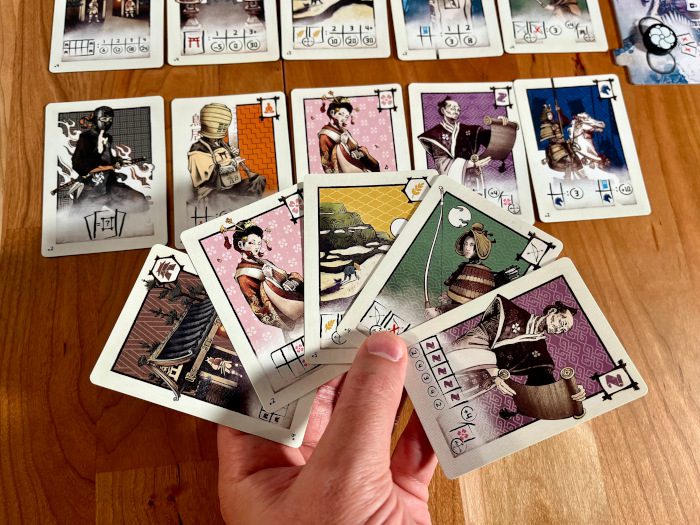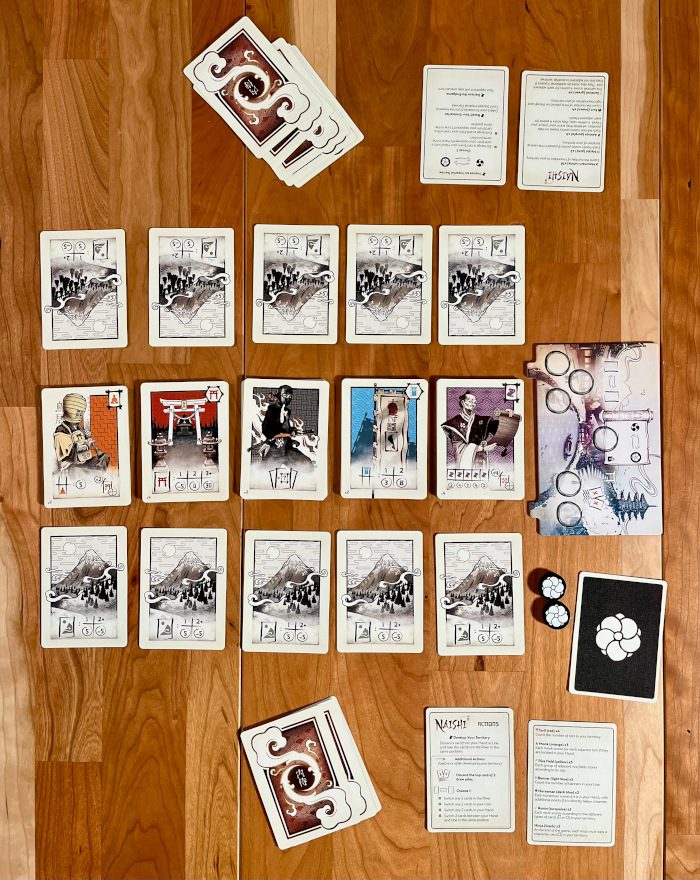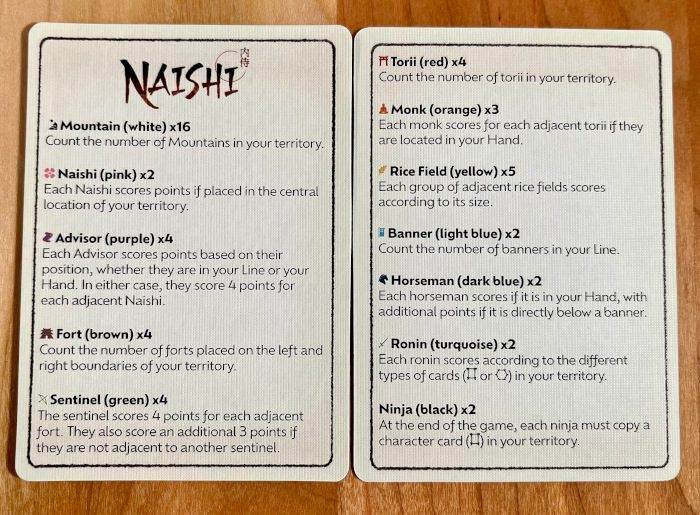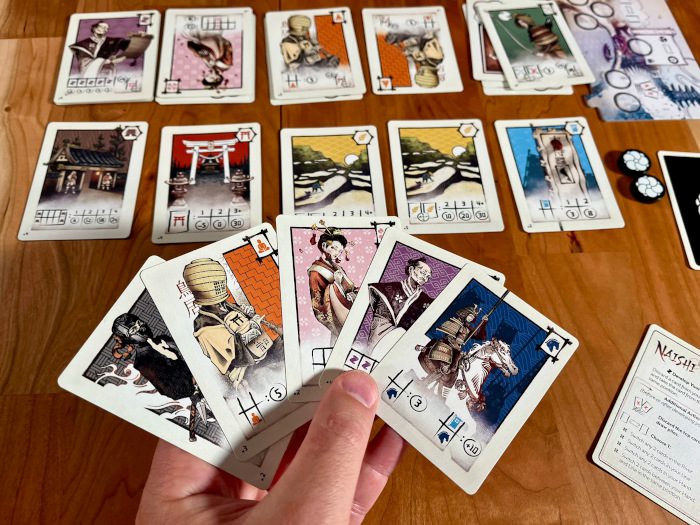Naishi is a card game where you position your cards in order to score points. It has a Japanese theme and uses hand management, open drafting, and pattern building. The real joy in this game is being clever where and how you place cards down so that you can surprise your opponent after revealing the 5 cards in your hand to pair with the 5 cards out for all to see. The game is for 2 players only, and plays in 20 minutes or less. The game is designed by Mathieu Bieri and Alex Fortineau and is published by Renegade Games.
What’s in the Box?
- 16 Mountain cards
- 34 Development cards (19 character cards, 15 providence cards)
- 1 Imperial Court board
- 4 Emissary tokens
- 1 First Player card
- 4 Player Aids
- 1 Scorepad

How’s it Play?
You will be swapping out cards from your hand and from your line to make the best placement of cards to score you the most points. You play the game with a hand of 5 cards and a line of 5 cards laid out in front of you. You swap these cards out, but you will not be able to re-arrange the order of these cards besides a swap from the development cards that are out.

At the end of the game you place down your 5 cards in your hand from left to right below the 5 cards in your line already shown from left to right and score them according to the cards and what locations those cards are in.
But, you begin the game with a bunch of mountain cards, and you need to take turns to get better cards in play to score points. You take turns with the other player and you can develop your territory by adding in new cards. You can impose an imperial decree by placing the emissary token on the imperial court on the board to exchange cards, you can recall your emissaries by taking back the tokens, or you can declare the end of the game if one of the river piles are depleted and you think you have a good arrangement of cards.
Develop Your Territory – You choose a card from your hand or from your line to discard. You take the corresponding card in the same position as the one you just discarded and place the new card in that empty space of your hand or line. You then reveal the next card in the river.

You can take an additional action either before or after you develop by sending one of your emissary tokens to a free space on the imperial court board and taking that action. These actions are to discard the top 2 cards on 2 piles in the river or switch the position of 2 cards.
Impose an Imperial Decree – Only the first player can take this action. They can place one of their tokens in the imperial court sport on the board, which locks that token for the rest of the game. They may then exchange a card from both players hand in the same position, or exchange a card from both player’s line in the same position.
Recall your Emissaries – Take tokens from the imperial court back to your area.
Declare the end of the game – If one of the river piles are empty, you can decide to end the game. Your opponent will be able to play one last turn. The game automatically ends when 2 piles in the river are empty.
Scoring is then performed according to your cards. Mountains score if you have 1, but if you have more they score negative points. Naismith cards score if in the middle. Advisors score different points depending on where they are located and get bonus points for being next to a Naismith card. Fort cards score for being on the ends. Sentinel cards score if not adjacent to another sentinel and bonus points if next to a fort. Torii score lots of points if you can manage to get 3 of them. Monks score 5 points a piece and more if next to torii. Rice fields score according their size. Banners score for having 1 or 2 of them. Horseman score 3 points but bonus when banner is on the same position in your line. Ronin score for having different types. And ninjas score by copying a character card present in your territory.

The Verdict
I really enjoyed this game, and for a game with the amount of cards that comes in the game mixed with the mechanics, the game does wonders. The gameplay include pacing, not a lot of downtime, and requires you to be intuitive. The game itself is smooth, with fast turns and back and forth playing. Each player has a row the other player can see, and a row in their hand the other player cannot see.

The game includes Japanese art and theme which works well for this game. Nothing crazy over the top, but just a theme and art that holds the game together. The icons do a good job reminding players what the cards do, and while you do have to remember some of these things, time will help where you know exactly what cards do.
The game is a tableau builder, where you are building half on the table and half in your hand. This game might do this better than others because of the way you can be clever with your choices, and also knowing half the information of what the other player is doing.
There are 11 different types of cards, and you can find plenty of combinations with them all. I think there is a lot of game in the few cards there are, and the fun factor can be high for this one. There are some times of tension with the other player, and all together it provides a fun experience to play over and over again, seeing if you can outsmart your opponent using different cards each time you play the game.

Images via Renegade Games.
Have strong thoughts about this piece you need to share? Or maybe there’s something else on your mind you’re wanting to talk about with fellow Fandomentals? Head on over to our Community server to join in the conversation!

